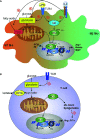Exploring the Role of ATP-Citrate Lyase in the Immune System
- PMID: 33679780
- PMCID: PMC7930476
- DOI: 10.3389/fimmu.2021.632526
Exploring the Role of ATP-Citrate Lyase in the Immune System
Abstract
Studies over the past decade have revealed that metabolism profoundly influences immune responses. In particular, metabolism causes epigenetic regulation of gene expression, as a growing number of metabolic intermediates are substrates for histone post-translational modifications altering chromatin structure. One of these substrates is acetyl-coenzyme A (CoA), which donates an acetyl group for histone acetylation. Cytosolic acetyl-CoA is also a critical substrate for de novo synthesis of fatty acids and sterols necessary for rapid cellular growth. One of the main enzymes catalyzing cytosolic acetyl-CoA formation is ATP-citrate lyase (ACLY). In addition to its classical function in the provision of acetyl-CoA for de novo lipogenesis, ACLY contributes to epigenetic regulation through histone acetylation, which is increasingly appreciated. In this review we explore the current knowledge of ACLY and acetyl-CoA in mediating innate and adaptive immune responses. We focus on the role of ACLY in supporting de novo lipogenesis in immune cells as well as on its impact on epigenetic alterations. Moreover, we summarize alternative sources of acetyl-CoA and their contribution to metabolic and epigenetic regulation in cells of the immune system.
Keywords: ATP-citrate lyase; acetyl-CoA; histone acetylation; macrophage; metabolism.
Copyright © 2021 Dominguez, Brüne and Namgaladze.
Conflict of interest statement
The authors declare that the research was conducted in the absence of any commercial or financial relationships that could be construed as a potential conflict of interest.
Figures


Similar articles
-
Mammalian SIRT6 Represses Invasive Cancer Cell Phenotypes through ATP Citrate Lyase (ACLY)-Dependent Histone Acetylation.Genes (Basel). 2021 Sep 21;12(9):1460. doi: 10.3390/genes12091460. Genes (Basel). 2021. PMID: 34573442 Free PMC article.
-
Modulation of matrix metabolism by ATP-citrate lyase in articular chondrocytes.J Biol Chem. 2018 Aug 3;293(31):12259-12270. doi: 10.1074/jbc.RA118.002261. Epub 2018 Jun 21. J Biol Chem. 2018. PMID: 29929979 Free PMC article.
-
ATP-Citrate Lyase Controls a Glucose-to-Acetate Metabolic Switch.Cell Rep. 2016 Oct 18;17(4):1037-1052. doi: 10.1016/j.celrep.2016.09.069. Cell Rep. 2016. PMID: 27760311 Free PMC article.
-
Novel insights into the role of acetyl-CoA producing enzymes in epigenetic regulation.Front Endocrinol (Lausanne). 2023 Sep 29;14:1272646. doi: 10.3389/fendo.2023.1272646. eCollection 2023. Front Endocrinol (Lausanne). 2023. PMID: 37842307 Free PMC article. Review.
-
ATP citrate lyase: A central metabolic enzyme in cancer.Cancer Lett. 2020 Feb 28;471:125-134. doi: 10.1016/j.canlet.2019.12.010. Epub 2019 Dec 9. Cancer Lett. 2020. PMID: 31830561 Review.
Cited by
-
Extracellular citrate and metabolic adaptations of cancer cells.Cancer Metastasis Rev. 2021 Dec;40(4):1073-1091. doi: 10.1007/s10555-021-10007-1. Epub 2021 Dec 21. Cancer Metastasis Rev. 2021. PMID: 34932167 Free PMC article. Review.
-
Acetyl Coenzyme A Synthase 2 Acts as a Prognostic Biomarker Associated with Immune Infiltration in Cervical Squamous Cell Carcinoma.Cancers (Basel). 2021 Jun 22;13(13):3125. doi: 10.3390/cancers13133125. Cancers (Basel). 2021. PMID: 34206705 Free PMC article.
-
Immunometabolism Modulation in Therapy.Biomedicines. 2021 Jul 9;9(7):798. doi: 10.3390/biomedicines9070798. Biomedicines. 2021. PMID: 34356862 Free PMC article. Review.
-
PTPN2 Regulates Metabolic Flux to Affect β-Cell Susceptibility to Inflammatory Stress.Diabetes. 2024 Mar 1;73(3):434-447. doi: 10.2337/db23-0355. Diabetes. 2024. PMID: 38015772 Free PMC article.
-
Aorta in Pathologies May Function as an Immune Organ by Upregulating Secretomes for Immune and Vascular Cell Activation, Differentiation and Trans-Differentiation-Early Secretomes may Serve as Drivers for Trained Immunity.Front Immunol. 2022 Mar 7;13:858256. doi: 10.3389/fimmu.2022.858256. eCollection 2022. Front Immunol. 2022. PMID: 35320939 Free PMC article.
References
Publication types
MeSH terms
Substances
LinkOut - more resources
Full Text Sources
Other Literature Sources
Miscellaneous

